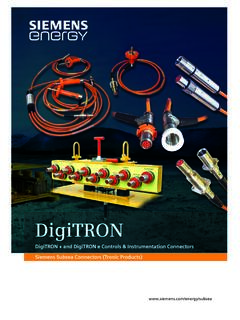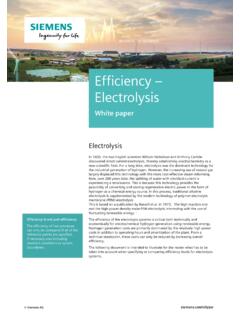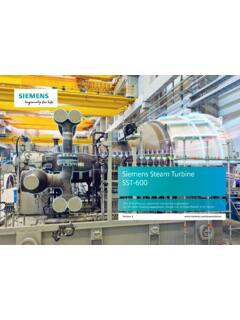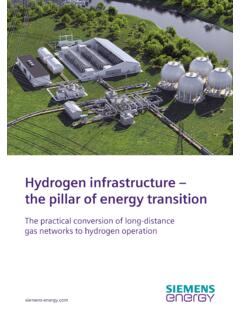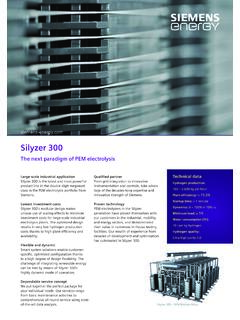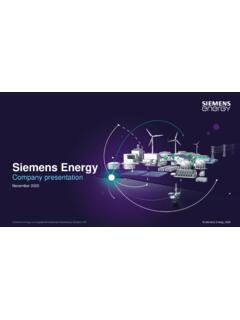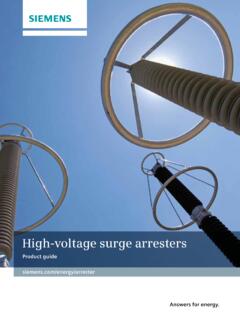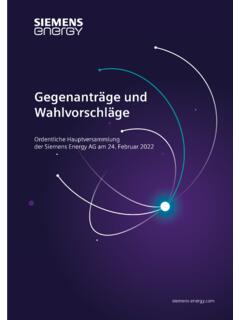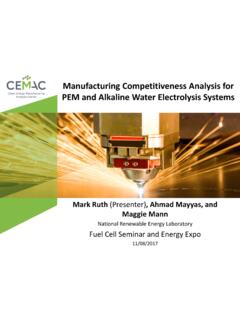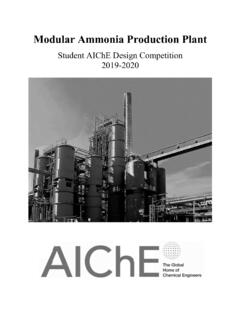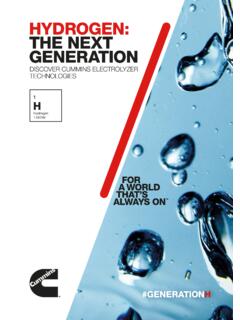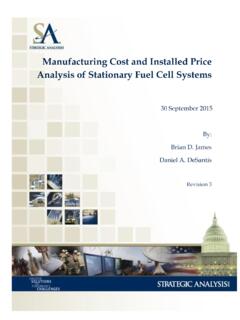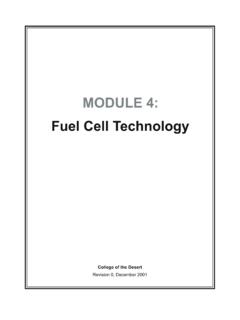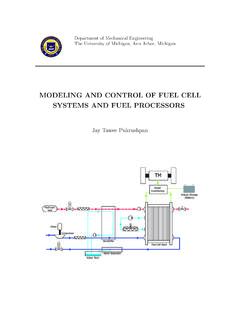Transcription of Siemens Energy · Technical document · DIN A4 portrait ...
1 Efficiency . Electrolysis White paper White paper l Efficiency Electrolysis l Dr. Philipp Lettenmeier Electrolysis In 1800, the two English scientists William Nicholson and Anthony Carlisle discovered direct current electrolysis, thereby establishing electrochemistry as a new scientific field. For a long time, electrolysis was the dominant tech- nology for the industrial generation of hydrogen. However, the increasing use of natural gas largely displaced this technology with the more cost-effective steam reforming. Now, over 200 years later, the splitting of water with elec- trical current is experiencing a renaissance.
2 This is because this technology provides the possibility of converting and storing regenerative electric power in the form of hydrogen as a chemical Energy source. In this process, traditional alkaline electrolysis is supplemented by the modern tech- nology of polymer electrolyte membrane (PEM) electrolysis. This is based on a publication by Russell et al. in The high reaction rate and the high power density make PEM. electrolysis interesting with the use of fluctuating renew- able Energy . The efficiency of the electrolysis systems is critical both technically and economically for electrochemical hydrogen generation using renewable Hydrogen generation costs are primarily dominated by the relatively high power costs in addition to operating hours and amortization of the plant.
3 From a Technical standpoint, these costs can only be reduced by increasing overall efficiency. Efficiency is not just efficiency The following document is intended to illustrate for the reader what has to be taken into account when specifying The efficiency of two processes can or comparing efficiency levels for electrolysis systems. only be compared if all of the reference points are specified, if necessary also including standard conditions or system boundaries. 2021 Siemens Energy Page 2. White paper l Efficiency Electrolysis l Dr. Philipp Lettenmeier Summary The efficiency of an electrolysis plant is one of its key parameters.
4 It is largely determining for power consumption and therefore the bulk of operating costs. On the other hand, efficiency is interrelated with all of the peripheral parameters that also influence hydrogen generation costs, such as operating mode (operating hours) service life and investment costs. For that reason alone, the definition, calculation and interpretation of efficiency in electrolysis technology merit a closer look. Stack, system and plant efficiency are often referred to in actual use of this technology. All three of these represent the products of various sub-efficiencies and are therefore not clearly defined.
5 Stack efficiency, which is sometimes also known as DC efficiency, is itself the product of Faraday efficiency (also known as current efficiency) and the voltage efficiency, which is often used as a characteristic curve for an electrolysis process due to the dominating losses. In an ideal cell, voltage defines the efficiency over the range of current densities. Figure 1: Schematic representation of a U/I characteristic and its indirectly proportional effect on efficiency. The so-called U/I characteristic is therefore also the most important graph in the evaluation of electrolysis technology. In addition to the dominating losses in the cell, various auxiliary loads must be accounted for in determining the efficiency of a system or plant.
6 The greatest challenge in this regard is to clearly define the boundaries of the system or balance. This affects not only the individual packages and their power consumption, but also the condition and quality of all parameters at the balance interfaces, such as water quality, waste heat, the quality of the electrical power and gas quality and pressure level. 2021 Siemens Energy Page 3. White paper l Efficiency Electrolysis l Dr. Philipp Lettenmeier Electrolysis efficiency Definitions of efficiency A systematic examination of the efficiency of an electrolysis The product with voltage efficiency can also be used de- plant for hydrogen generation yields many specifications pending on the definition of the system boundaries for for a wide range of system boundaries.
7 The most frequently Faraday efficiency. used parameters are presented below. DC= V . F (11). Faraday efficiency Faraday efficiency is the ratio of the actually produced and technically usable volume of hydrogen production and the theoretical maximum production volume. For example, it accounts for H2 diffusion losses through the membrane , electrical current losses or hydrogen losses through the conversion of oxygen contamination in the downstream hydrogen purification system. Mass losses due to sampling or other losses can also be included in the calculation.. mre H . F = . mid H (8).. Figure 2: System efficiency and its schematic shape mre H is defined as the actual production volume of usable.
8 Hydrogen and m id H as the maximum possible hydrogen pro- System/plant efficiency duction volume under ideal conditions. While the hydrogen community is somewhat in agreement regarding the above efficiency definitions, with the excep- Voltage efficiency tion of the nomenclature, the system boundaries for system Voltage efficiency is often confused with DC efficiency. or plant efficiency are defined arbitrarily. Depending on the Voltage efficiency is defined as the quotient of thermo- scope of supply, losses may also be included from AC/DC. neutral voltage Eth and the measured cell voltage conversion and transformation from medium voltage, water Ecell(i, T).
9 Thermoneutral voltage comprises the heat Energy treatment, the cooling systems, the provision of electrical bound by the change in entropy and is V under Energy for buildings and auxiliary packages or compression standard conditions. This is not to be confused with the and hydrogen purification. reversible cell voltage (Erev = V) that must be applied as The respective system boundaries must be investigated in a minimum to split water into its components of H2 and O2. corresponding detail to enable the comparison of efficiency The cell voltage, however, also includes all of the catalytic data.. and electrical losses within the DC-powered electrochemical VH ,interface customer.
10 HO. cell. Sys =. Pel, AC,interface grid (12). Eth v = (9). Ecell(i, T). DC efficiency DC efficiency comprises the efficiency of the stack or of a module. Ultimately, it represents the ratio of the Energy input to the stack in the form of DC current and the Energy content of the technically usable hydrogen at the stack output. Specification of the higher or lower heating value is relevant here.. VH HO. F = (10). Pel, DC. Figure 3: : Examples of system boundaries 2021 Siemens Energy Page 4. White paper l Efficiency Electrolysis l Dr. Philipp Lettenmeier U/I characteristic Operating parameter II temperature Temperature has a further significant effect on efficiency.
